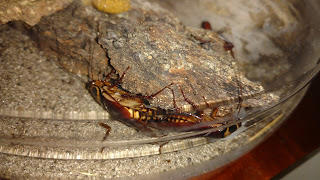Here is all that's left, I've counted around 28 or so, with one that had already hatched. I've placed them on moist paper towels rather than substrate to make it easier to catch the nymphs if they hatch and I need to move, or ship them. Hopefully these are still viable.
Monday, September 18, 2017
Picking up the pieces.
The Periplaneta americana colony is a total loss, but hopefully the ooth are more resilient, I used said room mates strainer to sit throughout the substrate to gather the other, I'm sure some slipped through but no biggie.
Sunday, September 17, 2017
Disaster.
Well while I was gone a right bastard of a room mate moved my roach colonies outside, and they got hit by direct sun and the Periplaneta americana colony is destroyed. I will attempt to salvage the ooths, but I'm not hopeful. And considering I was trying to breed a giant strain, the individuals lost were irreplaceable, and I'm unable to get more.
The giant one is on the right, but the other two were still larger than many other Periplaneta adults I've seen. The Surinames have been wiped out as well.
The Australian roaches are thankfully ok, I will do a more detailed check for casualties later but initial inspection seems promising.
The giant one is on the right, but the other two were still larger than many other Periplaneta adults I've seen. The Surinames have been wiped out as well.
The Australian roaches are thankfully ok, I will do a more detailed check for casualties later but initial inspection seems promising.
Thursday, September 7, 2017
Love, hurricanes and babies...
Well interesting things are occurring, along with Hurricane Irma, moving and not much to report until now. We finally have progress. I've been able to witness mating and brooding behavior of my roaches, and finally after waiting more than a month I have the first babies/nymphs.
It's not often a roach keeper will see mating since roaches often only mate once, unless the male was infertile.
It's not often a roach keeper will see mating since roaches often only mate once, unless the male was infertile.
Egg laying roaches like Periplaneta often carry around their ooths until they find a suitable location, if they can't they will either simply drop them, or more dedicated females will painstakingly bury and disguise them. The next series of photos will show a female Periplaneta americana disguising her ooth, by gluing grains of sand to it, and then trying to hide it.
These are in order, as you can see she buried her ooth quite deeply, after disguising it as a lump of sand, and then covering the site with objects she found.
And now for the ooth.
These were found some time before July 16, at incubating at 80 to 90 degrees one finally hatched on September 7th. Such high temps are generally unnecessary, with 75 to 80 degrees Fahrenheit being adequate for most roaches, along with a moist substrate. Periplaneta are not a fussy species.
Two remain unhatched, but I'm sure they will hatch soon. And finally here are the sadly blurry pics of the newly hatched Periplaneta australasiae. There were around six or so.
Now all this is going on with Hurricane Irma barrelling down on my location, so I will be evacuating along with these guys, so I may be gone for awhile, the roaches can handle dog food and water rations with no issue for a few weeks. Well I'm out.
Subscribe to:
Posts (Atom)


























